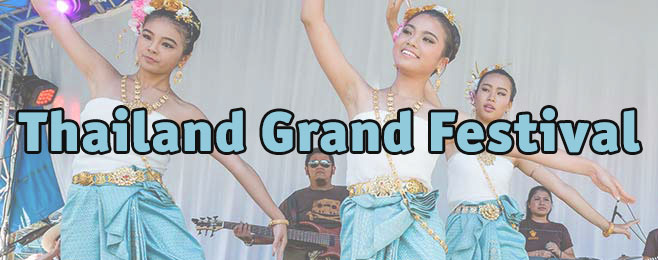Bun Bang Fai Rocket Festival
In a country where agriculture and farming sustains the livelihood of over 70 per cent of the population, the festivals and ceremonies associated with a bountiful harvest are central elements of the way of life in the rural communities. Agricultural productivity and abundance are the principle objectives of both the royal as well as the folk traditions. These rituals performed on auspicious dates in the sixth lunar month (approximately in May) signal the beginning of the planting season.
Born of the traditional beliefs of the Isan people, the sprightly "Bun Bang Fai" Rocket Festival, the most celebrated of Isan's merit-making rituals, has been strictly observed by the residents of Isan for generations and is essentially an annual ritual to ensure that the seasonal rains fall at the appropriate time in the planting cycle. In this process, Buddhist merit-making traditions are also observed and reinforced.
Highlights of the annual Bun Bang Fai celebrations being held this year include a procession of old-style rockets mounted on traditional carts, a beauty pageant, cheerleader contests, and a traditional 'Palaeng' I-san style dinner.
The festival which is held over a period of three days strengthens community spirit. The first day known as "Wan Sook Dib" features lively processions as rocket teams transport the "May 8 - 10, 2009" rockets in a procession and perform a ritual to pay homage to Chao Pu, the spirit of the city pillar. Each is escorted by a colourful dance troupe.
The second day is the rocket procession day. Modern-day rockets are mounted on vehicles or traditional carts to be drawn in the parade. The "Bang Fai" rockets come in different sizes. For example, the Bang Fai Kilo is packed with one kilogram of nitrate, while the Bang Fai Meun - 12 kilograms, and the Bang Fai Saen - 120 kilograms of nitrate. The rocket-making technicians play a vital role in deciding the right amount of nitrate to be mixed with the charcoal. With the wrong formula, a rocket could blow up prematurely before it is launched high into the sky. The rocket cylinders are usually made from the bottom half of the bamboo.
It is also a day for the ordination of novices. Festive celebrations follow merit-making rituals. Dance, music, song and revelry are integral elements of the processions as the parade of beautifully decorated rockets wind their way through the village on their way to the temple offering an opportunity for the residents and visitors to admire the impressive works of art.
The rockets are finally launched on the third day in which various rocket contests are held. With the launch of the rockets, predictions are made with regard to the fortunes of the coming harvest. The Rocket Festival in Yasothon Province is spectacular and provides a tremendous opportunity to experience Isan-style festive fun.
The Rocket Festival stems from the belief that when this merit-making ceremony is held, gods and spirits will reciprocate with seasonal rain and a bountiful harvest.
HIGHLIGHTS
- Bun Bang Fai rocket contests
- Processions and parades
- Cheerleading contests
- Miss Bun Bang Fai beauty contest
- Fun fair
- Stage drama
- Open-air theatre
- Folk music
- Mor Lam folk performance
- And other folk entertainment
YASOTHON HIGHLIGHTS
Wat Phra Si Mahathat Temple
Located within the Yasothon municipality, this is an important temple that has existed since the founding of the original community.
Phra That Yasothon (also known as Phra That Anond)
This is one of the oldest key stupas in the northeast and enshrines the ashes of Phra Anond. Its architecture reflects the influence of Laotian art that was popular during the late Ayutthaya - early Rattanakosin period.
The Phra That Yasothon sits on a square base each measuring 81 metres and is built of brick and mortar with a tapered mid-section featuring lotus motifs facing up and down. The arches on the four compass points are adorned with standing Buddha images.
Kong Khao Noi Stupa
Built during the late Ayutthaya period, the Kong Khao Noi Stupa is shaped differently from other chedis or stupas. It takes the form of a "kong khao" or indigenous rice container with an angular structure over a square base.
Legend has it that a young man who had been working the fields since the early morning was furious with his mother because it was noon and she was late in bringing him his lunch. Additionally what food she brought was deemed to be too little to satisfy his appetite. Overcome with rage, he struck his mother and killed her.
After he had eaten his fill, he discovered to his horror, that there was still food left in the container. The young man proceeded to build a chedi or stupa in a gesture of repentence and to seek forgiveness and absolution.
The mid-section is adorned with patterns in the form of arches and the upper part tapers into a peal.
Cottage industries at Ban Si Taan
Following the harvest, the villagers in Yasothon province and the adjacent areas turn to handicraft to supplement their income. The area is famous for triangular- shaped pillows called "Mon Kwan", Lai Khit traditional textiles, intricate wood-carvings particularly miniature traditional carts or "kwian noi", wickerwork and basketry such as the traditional sticky rice containers of I-San called "Kratib".
Ban Nasmai is also known for utensils made from copper.
Agro-gardens and organic farming
Herb gardens at Amphoe Kootsoom district
Culinary highlights
The best known of the local specialties are:
"Pla Som" is a salted carp stuffed with sticky rice that is deep-fried and topped with onions and garlic.
"Lod Chong", or pressed rice vermicelli served with a fresh coconut cream and palm sugar syrup on a bed of crushed ice.
